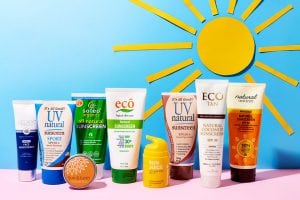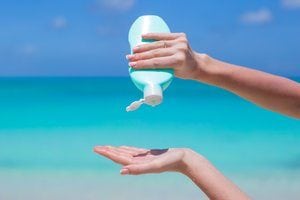It’s been a great summer and the sunshine looks set to continue for some time yes! That’s good news on almost every front – except for one. We all love being out in the sun but spending too much time in the sun without proper protection can lead to health problems – from heat stroke to skin cancer. One of the best ways to protect yourself from the sun is of course, sunscreen. As you will have noticed if you’ve been shopping recently however, there’s now a myriad d of bottles and tubes on show, all making different claims. So, Wait’s the difference between UVA and UVB radiation? What’s behind those long, unpronounceable ingredient names? And does it really matter which sunscreen you buy? This week lets find out!
Is all sunscreen created equal?
In a word, No. Some products do just work better than others. What’s more, even some sunscreens claiming to be ”natural” may contain toxic, possibly disease-causing ingredients. In general, more natural products are going to be a better bet – well talk about some of the chemicals to avoid in a moment but choosing a more natural product can also go a long way to minimise the risk of allergic reaction.
UVA and UVB: Are You Protected?
Two types of ultraviolet radiation from the sun affect our skin: UVA and UVB rays. Its UVB rays which are important for their role in helping the skin produce vitamin D, but overexposure causes sunburn.
All commercial sunscreens contain active ingredients to protect against UVB rays. The sun protection factor (SPF) on a bottle of sunscreen indicates the level of protection the product provides compared to unprotected skin. But here’s an important point – the relationship between SPF number and the actual protection provided is not a linear one, in fact according to the American Cancer Society, a sun screen labelled SPF 55 is less than two percent more effective than one labelled SPF 30. Higher SPF varieties may also contain more possibly harmful chemicals, so the choice isn’t always a simple as its made out to be!
While all commercial sunscreens protect against UVB rays, not all block UVA rays. UVA rays cause tanning more than burning but are linked to premature aging of the skin and skin cancer[1]. Sun screens that offer UVA protection are often labelled as “broad-spectrum” or “complete protection”, so look for these.
To further complicate matters, the testing used to determine SPF values is actually imperfect. According to researchers, the instruments used in this process have limited precision[2]. Even when ratings are accurate, the average user applies sunscreen at a quarter of the concentration used in lab testing, hence making it less effective than the number on the bottle implies[3].
Ingredient Safety
In addition to the SPF, the other key details for the consumer are the ingredients used. Safe ingredients are important in any personal care product – However, because sunscreen is applied over large areas of skin, often multiple times a day, its ingredients should be a particular concern. Research has shown that the skin can absorb many of the active ingredients in sunscreens, which you should keep in mind when picking your sunscreen[4].
So, are the ingredients in sunscreen safe? There is no easy answer. Which ingredients are allowed, their safety testing and their maximum concentrations are regulated differently in different countries.
In the United States, sunscreens and their allowable active ingredients fall under the purview of the Food and Drug Administration, which has been criticized for not establishing more stringent rules for ingredient safety testing and labelling claims. Australia and Canada consider sunscreens to be drugs and have stringent guidelines for ingredient safety and product labelling. The European Union regulates sunscreens as cosmetics, controlling ingredient safety but only making non- binding recommendations about their efficacy and labelling, so its hard to say that there are any real global guidelines for this issue.
The best option is simply to be informed about some of these common ingredients, and to make your own choices with the facts in hand – so, lets take a look at some ingredients:
Oxybenzone
Oxybenzone is a chemical which is particularly easily absorbed into the skin – in fact, one of its roles in sunscreen is to enhance penetration of other ingredients. Centers for Disease Control studies found oxybenzone in the urine of 97 percent of people who used it topically.
Oxybenzone is also an endocrine disruptor, which means it can affect your hormonal function and may interfere with reproductive activity. Some people are also allergic to Oxybenzone.
Octinoxate
Octinoxate has the benefit of being a low-allergenic UV filter. However, it is another endocrine interrupter. Multiple animal tests show that octinoxate decreases hormnone levels, affecting thyroid function, sexual maturation, and reproduction[5].
Zinc oxide and titanium dioxide
Both of these are minerals that act as physical blockers -they reflect UV rays away from the skin, unlike chemical blockers that absorb UV rays. They are touted as safe sunscreen options because they are not absorbed into the skin, and they very effectively protect against both UVA and UVB rays.
Many products use one or both of these minerals in the form of nano-particles, microscopic particles developed to prevent the opaque white streaks of traditional mineral-based sunscreens. Such products may be labelled ”clear zinc.” Researchers show mixed results on the safety of this cutting-edge technology, however. Because nanoparticles are so tiny, some studies suggest that they could interact with and damage DNA[6] although scientists are continuing to learn more about the health implications of nanoparticles in sunscreen and other skin products.
Phthalates
Phthalates are a class of chemicals best known for their use in plastics, but they also appear in many personal care products and are usually labelled as ”fragrance”. Numerous studies have shown endocrine interruption in animals exposed to phthalates, and newer research implicates their impact on humans in such conditions as breast cancer and hindered foetal testicular development[7].
Parabens
Parabens are a class of preservatives used in many personal care products, which you have heard about recently in the news. Like many other questionable ingredients, they have potential to disrupt the endocrine system. Besides interfering with development of reproductive organs, parabens appear to have a toxic effect on the thyroid in young female rats[8].
These effects become even more pronounced when various parabens are combined as is the case in most products that use them. Furthermore, two studies indicate that methylparaben may become a carcinogen when ex posed to sunlight, as it certainly would be when included in a sunscreen. Since many companies are now rushing to produce paraben free plastics, you probably also want to keep the out of your sunscreen.[9]
So how do I pick a safe sunscreen?
It might seem counter intuitive but the first question to ask yourself is – “do I even need sunscreen?”. It’s actually important that you do get some moderate sun exposure without sunscreen to ensure vitamin D production- this generally means enough sun to make the skin barely begin to tum pink but not begin to burn. You can read more about sun safety and vitamin D here.
Additionally, its often not necessary to use sunscreen if you’re wearing a shirt or hat – especially if you have UV protective clothes, which are usually far more effective then sunscreen.
When you do choose a sunscreen, it’s probably better to choose a mineral based product – at least until research says otherwise. If you do use a chemical-based sun screen, reapply often since many of these active ingredients break down in the sun. For the same reason, do not leave sunscreen outside or in the car for extended periods, as heat breaks down their effective ingredients. Try also to be careful with using spray vs. cream-based products – avoiding inhaling sprays!
[1] J Invest Dermatol 2010; Epub
[2] Skin Pharma col Physio l 2010;23:201- 12
[3] J Am Acad Dermatol 2010;62:218-22
[4] Photochem Photobiol Sci 2010; 9:482-8
[5] Tox icology 2007;238:192-9; Exp Clin Endocrinol Diabetes 2008;116:94-8
[6] Toxicol Lett 2009;185:21 1-8
[7] Environ Health Per spect 2010;118:539-44;. Folia Histo chem Cytobiol 2009;41:S67-74
[8] Reprod Toxicol 2010; 29:306-16
[9] Chem Res Toxicol 2008;21:1594-99; Toxicology 2006;227:62-72



